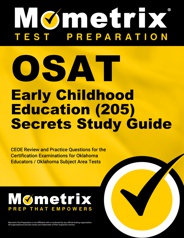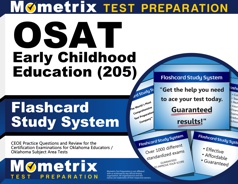The OSAT Early Childhood Education exam is designed to test the knowledge of entry-level educators wanting to teach in the state of Oklahoma.
Click “Start Test” above to take a free OSAT Early Childhood Education practice test, and check out our premium-quality OSAT test prep resources by clicking the links below!
OSAT Early Childhood Education Exam Outline
The OSAT Early Childhood Education exam contains 80 selected-response questions and one constructed-response question, and you will be given a time limit of 4 hours.
The exam is split into five subareas.
I. Child Development, Language, and Learning (16%)
The questions in this subarea cover the following topics:
- Early childhood development from birth through grade three
- Factors that influence children’s development and learning
- Expressive and receptive language development
- Providing learning experiences that encourage children’s development and use of language and literacy skills
- Cognitive development of young children
- Providing instructional activities and a classroom environment that offer young children opportunities to develop a range of cognitive skills and abilities
II. The Learning Environment, Physical Development, and Assessment (21%)
The questions in this subarea cover the following topics:
- Methods, strategies, and procedures to create and manage positive learning environments for children in prekindergarten through grade three
- How various types of instructional materials and resources can be used to support young children’s learning
- Young children’s physical development and their needs related to personal health, safety, and nutrition
- Strategies for providing developmentally appropriate experiences and environments
- Goals, benefits, types, and uses of assessment to support young children and their families
III. Learning Across the Curriculum (34%)
The questions in this subarea cover the following topics:
- Emergent literacy development
- Effective instructional strategies for promoting children’s knowledge and skills in phonological and phonemic awareness
- Word identification strategies
- The use of explicit and implicit instruction to promote children’s knowledge and skills in applying word identification strategies
- Reading comprehension, reading fluency, and vocabulary skills
- Writing processes
- The fundamental skills, concepts, and vocabulary in mathematics
- The skills and concepts in science and social studies
- The role of the arts in the overall development of young children
IV. Professional Knowledge and Responsibilities (14%)
The questions in this subarea cover the following topics:
- Strategies for building positive, collaborative relationships with children’s families, other professionals, and community agencies and organizations
- The roles and responsibilities of early childhood teachers
V. Analysis of Young Children’s Learning (15%)
This subarea contains the one constructed-response question. You will be given a set of data and identify areas of need and describe developmentally appropriate strategies to effectively address individual student needs.
Check Out Mometrix's OSAT Early Childhood Education Study Guide
Get practice questions, video tutorials, and detailed study lessons
Get Your Study Guide
Exam Registration
To register for the OSAT Early Childhood Education exam, you must create an online NES account via their website. Once your account has been created, you can use it to register for the exam and schedule an exam date. When you register, you will need to pay the $118 exam fee.
Test Day
In-person Testing
You should arrive at the testing center 30 minutes earlier than the scheduled appointment. When you arrive, you will be asked to sign in and present a valid form of photo ID to the proctor. If you fail to bring your ID, you will not be able to take the exam.
Personal items are not allowed in the testing room, so they must be stored in a secure locker outside the testing area. This includes your cell phone, wallet, keys, and accessories.
Just before the exam starts, you will be given a brief tutorial on the testing system.
Remote Testing
On the day of the exam, you should log into your testing account 15-30 minutes prior to the scheduled appointment time. The proctor will ask you to show a valid form of government-issued photo ID, and they will ask you to scan your surroundings using your webcam.
Once your exam begins, you cannot leave the webcam view, take breaks, or talk to yourself. Your focus must be on the exam, and other people must be out of your testing space while you take the exam.
Should the proctor determine that you are not following the guidelines for remote proctoring, your exam can be canceled, and your registration fees forfeited.
How the Exam is Scored
Your OSAT score is determined by taking your raw score (the number of questions you answered correctly) and converting it to a scaled score. To pass, you will need to get a minimum scaled score of 240.
You will receive your official score report within four weeks after testing.
Check Out Mometrix's OSAT Early Childhood Education Flashcards
Get complex subjects broken down into easily understandable concepts
Get Your Flashcards
FAQs
Q
How many questions are on the OSAT Early Childhood Education exam?
A
There are 81 questions on the exam.
Q
How long is the OSAT Early Childhood Education exam?
A
The time limit for this exam is 4 hours.
Q
What is the passing score for the OSAT Early Childhood Education exam?
A
To pass the exam, you must achieve a minimum scaled score of 240.
Q
How much does the OSAT Early Childhood Education exam cost?
A
The examination fee is $118.
